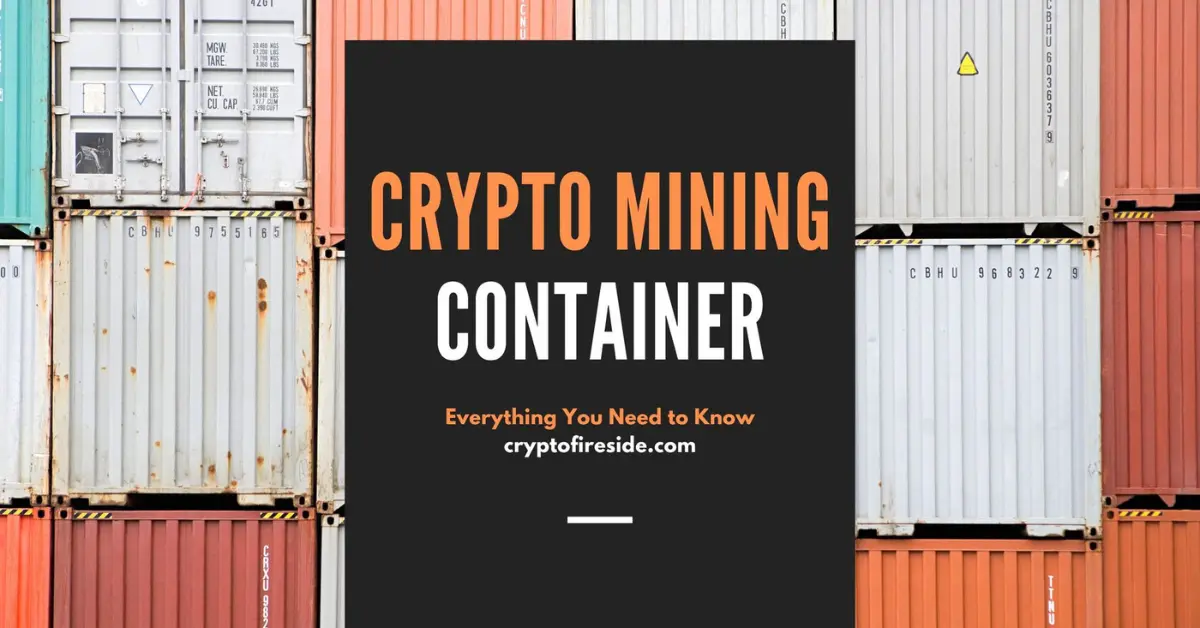Crypto Mining Container | The Ultimate Fast Guide
What are they, how much do they cost and what are the most important things to consider?

So, you're doing a little bit of research on a Crypto Mining Container ey?
Let us help out. And just know this, by the way, cryptofireside.com does not sell crypto mining containers, we do not get paid if we refer you to anyone and we make no affiliate commissions if you decide to buy one or not. We are completely independent and we like it that way.
We're just crypto nerds that love exploring any and all topics in the cryptocurrency space and we decided that a little bit of independent research in the area was required seeing that if you search for "Crypto Mining Container" all you will get are dozens of sales pages from companies all over the US and the world trying to sell you their containers.
No independent, research, no independent thoughts, opinions, or comments, just sales pitches. And that's all good, but not if you are trying to make a buying decision because you're not going to get fair and independent information. And it's not exactly like it's cheap.
Below we will cover the following:
- Crypto mining container costs.
- What crypto mining containers come with.
- Important considerations.
- Electrical specifications.
- Cooling specifications.
- Size.
- Quantity of miners.
- and more...
Crypto Mining Container - What Is It?
First things first. What even is a crypto mining container?
Just as the words hint at, a crypto mining container is just that - a container that is used for cryptocurrency mining.
Specifically, a crypto mining container is a shipping container that would normally be used to ship products, food, and materials all over the world, but importantly, in this case, one that has been renovated and retrofitted with bitcoin and crypto mining equipment.
The containers house and store mining rigs, the cooling systems and fans required to keep the mining equipment cool, and all of the wiring, racking, lighting, and sometimes even noise-reducing equipment.
Why Use a Container?
The one-word answer to this is mobility.
Crypto and bitcoin mining containers offer the owners and investors the option to easily move their mining setups. The genesis of the crypto mining container is the shipping container, and shipping containers are designed from the ground up to be easily transportable, it is part of their genetic code.
These things are shipped all over the world on ships and then finally on the back of flatbed trucks and eventually moved into place either by a forklift, crane, or both.
Why Would a Bitcoin and Crypto Mining Container Need to Be Moved?
Reasons vary only slightly but mostly this is due to electricity cost. Because the cost of electricity is the number one factor in mining profitability when a bitcoin and crypto mining operation can be picked up and moved to a location where you can save money on electricity costs, of course, the miners will actively pursue these types of lower-cost sights.
Drilling down into this (pun intended), oil extraction sites use a process called gas flaring where the oil extraction creates associated gases that are then 'flared' for various reasons including but not limited to safety, by reducing overpressure or due to other more general economic challenges such as capturing, storing, transporting and distributing the gas, this is especially true in remote locations.
Gas flaring produced 144 billion cubic meters of gas in 2021. If these gases could be properly harvested and used, they could power the whole of sub-Saharan Africa.
The benefits of mobile crypto mining solutions when combined with gas flaring operations are so obvious and powerful that we are now seeing top oil and gas producing companies like ExxonMobil directly mining bitcoin as part of its strategy to reduce emissions.
The process from a bitcoin miner's point of view is simple: locate and target an oil producer that is flaring gas, ask to use their gas for bitcoin and crypto mining, move your crypto mining container to their site, hook up a generator, and away you go!
This is a win for all involved.
Who Makes Bitcoin and Crypto Mining Containers?
There are a growing number of companies both in the US and overseas that are now specializing in the design, building, and distribution of mining containers.
Some notable companies are listed below:
- Chinese-based LANDY.
- EZ Blockchain which operates in Europe and the United States with offices in Chicago, Houston, and Tallinn Estonia.
- Wattum is a crypto mining equipment distributor based out of Florida, United States.
- Latvian-based Power Mining.
- Kontena, a Belgium-based mining products, and services company.
- Bitfury with offices and locations in Canada, the US, UK, Norway, Amsterdam, Ukraine, Georgia, Kazakhstan, and Hong Kong.
- Verakari, a Pennsylvania-based company specializing in custom-built Bitcoin mining containers.
Not all mining containers are designed and developed by these larger companies. Some are still made and put together by one-man-band-type hobbyists and backyard or garage crypto miners.
And of course, as with many things nowadays, mining containers can now even be found on sites such as the Alibaba marketplace.
How Much Does a Crypto Mining Container Cost?
This depends on the size, specification, and transport involved to get it to where it needs to be.
Prices range dramatically when looking at the entire landscape of options.
We have seen prices range from under $12,500 for a 20-foot option and as high as $375,000 for a 40-foot immersion cooling option.
From our research, we found that on average the cost appeared to be in the range of about $1,500-$2000 per foot of container. Meaning that most of the 20-foot containers we found were priced at about $30,000-$40,000 and 40-foot container options were priced at about $60,000-$80,000.
Be aware though, that this was taking a global approach. If we remove the more affordable Chinese and Eastern European options the cost per foot goes up to $2000+ easily.
These prices also do not indicate transport and setup costs.
Crypto Mining Container Size
Most mining containers come in two sizes, 20-foot, and 40-foot options. The reason for this is that most shipping containers are manufactured and used within the shipping container and logistics industries in these two sizes meaning there is a healthy supply of containers in these sizes.
There are some companies manufacturing containers right off the assembly line so to speak or taking made-to-order requests for more unique sizes such as the very small 10-foot and 12-foot options or even the larger 38-foot option which sits just under the 40ft option.
Essentially the answer is that crypto mining containers come in all shapes and sizes. Whatever size a shipping container comes in, is the size that you can buy a crypto mining container in. For example; 8ft, 10ft, 12ft, 15ft, 20ft, 38ft, and 40ft.
How Many Mining Machines Fit Inside of a Crypto Mining Container?
That depends on three things.
- The size of the container.
- How it is designed internally.
- The size of the mining machine.
The digital currency group Foundry reported in a video with CoinDesk that some of its 20ft containers can hold up to 162 miners and that its own 40-foot container can hold between 250-378 miners depending on the type of miner used. This includes the power-source box too.
Another crypto-mining company Viperatech, claims that its 40ft Antbox solution can hold a whopping 600 Antminer S9 models and EZ Blockchain claims its 40ft EZ Smartbox solution can hold 768 miners although it does not specify on which model miner so it is likely referring to the smaller models such as the S7, S9, AvalonMiner 741 or the DragonMint 16T.
From our research, it appears that one of the main contributing factors is whether or not the mining container offers walk-in access or not and how big that walk-in access space is.
The mining containers with large walk-in door accessibility have reduced space for mining machines because, well, they need to allow for someone to be able to walk inside, inspect, and service or maintain the mining machines.
Mining containers with reduced or no walk-in access are able to comfortably fit increased units. Its recommended that if you are considering buying or investing in a mining container, you should clarify which kind of machine the container is designed to house and the maximum quantity of machines that the container can comfortably hold.
How Are Crypto Mining Containers Cooled?
Heat management, airflow, and cooling are some of the most important criteria when considering which type of container to buy or when designing a container.
Just like with the cooling of any home or workplace, there are various different options for cooling the inside of a crypto container. Most crypto mining container producers cool the inside of their containers with fans, evaporative cooling units, thermal water curtains, filters, and outlet vents.
When producers design cooling systems for the inside of containers they will usually calculate the amount of airflow required per miner. For example, the Antminer S19 requires 400 cubic feet per minute of airflow, and the S9 requires approximately 200 cubic feet per minute.
They will take that and multiply it by the number of miners so that they can gauge how much cool airflow is required to be put into the miner's air-inlet so that hot air is not just cycling through the container, which would just decrease the overall efficiency.
Once they know this, they can decide on the number of fans or other cooling systems that are required to accommodate the amount of airflow that is required as well as the type, quantity, and sizes of vents and or louvers.
If you have designed your container to allow for 300 S19 miners and you have enough power then we can safely say that you will need 120,000 cubic feet of airflow per minute which means you can now acquire enough fans to do the job.
The idea as with any type of cooling system design is to get cool air in, and hot air out. That is of course if we are talking about air-cooling systems, because the alternative option, immersion-cooling, is something that is completely far off and away from what we are discussing here.
What Are the Power Requirements for a Crypto Mining Container?
As with everything else that we have discussed so far, this depends on a number of factors. Usually, you will need to calculate the total power required to run the miners, the cooling systems, and of course any other lighting or power requirements.
Being a general guide, we are not going to provide power specifications as we would just be making them up. Many of the 40ft containers we have reviewed so far have the following general specifications:
- 1.0 - 1.5 Total capacity megawatt power rating.
- 1.5 Megawatt transformer.
- Multiple 400 V, 3-Phase power supply leads.
- 1200 - 1400KW operating power.
Almost all of the crypto mining container suppliers will have specification sheets on their website or inside of their brochures and manuals which will provide this information. If you cannot find it, reach out and ask them.
What Other Criteria Should Be Considered When Thinking About a Crypto Mining Container?
There are a number of other things you should consider such as:
- Ethernet and power supply.
- AC v DC. This will depend on your chosen miner.
- Will you need any plumbing for cooling?
- Power Distribution Boards.
- Noise pollution and safety. Think about PPE and hearing protection.
- Electrical safety. This will be applicable for anyone installing your container and anyone working on it and will depend on your location as standards and rules differ from the EU to Australia and the US.
- Fire hazards. Will you need safety exists or safety lighting?
What Are the Overall Benefits of a Crypto Mining Container?
Benefits include the following:
- Increase in overall pool performance.
- Power efficiency.
- Portable and ready to use.
- Cost-effective.
- Space-saving design.
- Plug-n-play solution.
One of the main benefits of a crypto mining container is that it does not need to be a static long-term solution that is stuck in one place. They can be picked up and moved to where power may be cheaper.
As we discussed at the very beginning of this article, natural gas is sometimes vented off and flared from oil facilities, miners can come in, connect to the gas, hook it up to a generator and begin utilizing that gas that would normally just be burned off into the atmosphere.
The process of utilizing the flared gas is sometimes referred to as carbon capture, but really it's just better utilization and efficiency of oil extraction and when you think about it, all of that efficiency can now be turned into valuable bitcoin. Pretty cool.
Crypto mining containers are designed with mobility at their core as we have repeated. Some mines can be operated in very remote locations through satellite, meaning no tethered internet connection is required. The right partners are obviously required to be able to get you hooked up because there is hardware such as satellites that are involved and of course, latency issues need to be considered.
Thanks for reading! If you enjoyed this article, please share it!
Or if you'd like to continue to read more about mining, check out some of our other articles and interviews below.
- Is Bitcoin Mining Profitable in 2022?
- BKDilse Founder of The GNTL Project and Most Recently GNTL Coin — “A Coin for Miners By Miners”
- How to Mine Firo (FIRO)
- Meet Mark Zhou — The Chinese Entrepreneur Building a Global Cryptocurrency Mining Ecosystem
Want to know how you can support Crypto Fireside?
Sign up below. It's free and easy 🔥.

